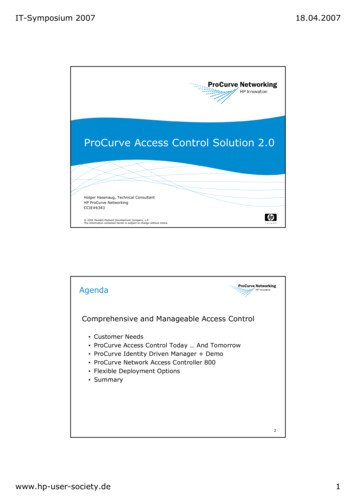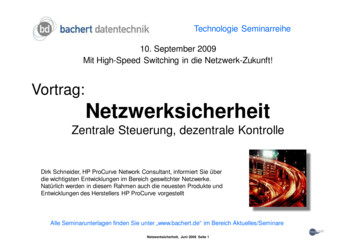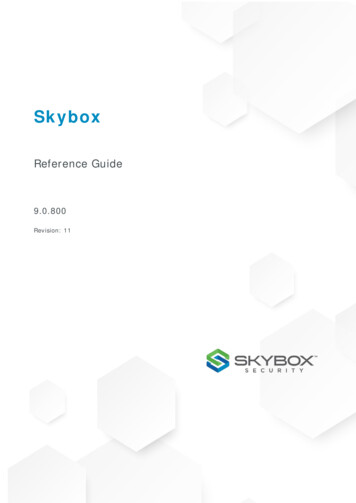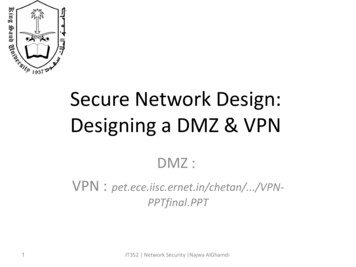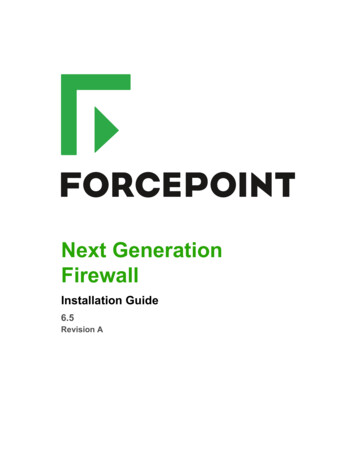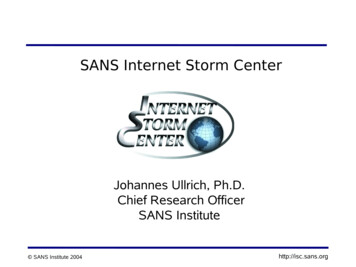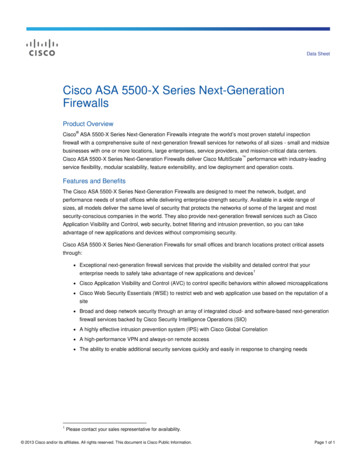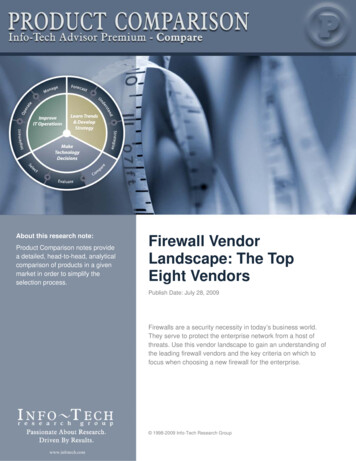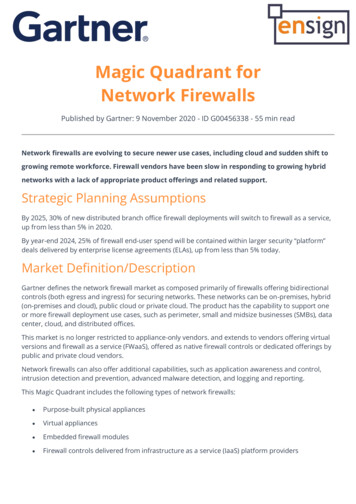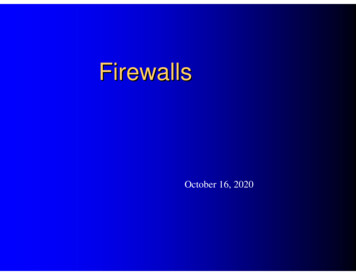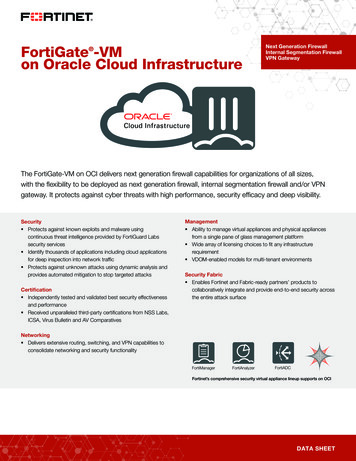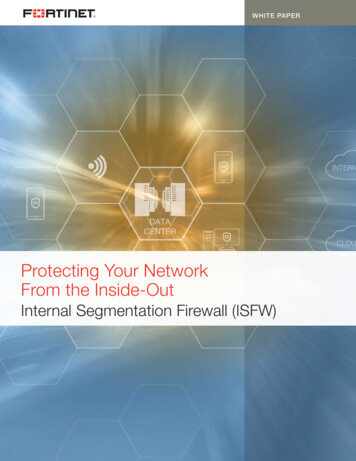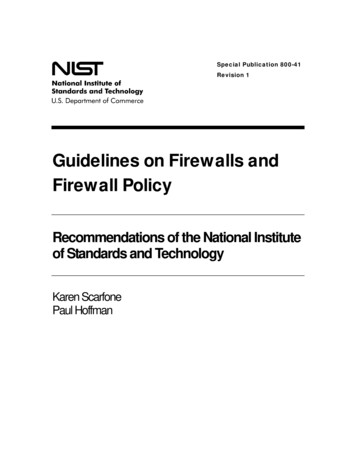
Transcription
Special Publication 800-41Revision 1Guidelines on Firewalls andFirewall PolicyRecommendations of the National Instituteof Standards and TechnologyKaren ScarfonePaul Hoffman
NIST Special Publication 800-41Revision 1Guidelines on Firewalls and FirewallPolicyRecommendations of the NationalInstitute of Standards and TechnologyKaren ScarfonePaul HoffmanC O M P U T E RS E C U R I T YComputer Security DivisionInformation Technology LaboratoryNational Institute of Standards and TechnologyGaithersburg, MD 20899-8930September 2009U.S. Department of CommerceGary Locke, SecretaryNational Institute of Standards and TechnologyPatrick D. Gallagher, Deputy Director
GUIDELINES ON FIREWALLS AND FIREWALL POLICYReports on Computer Systems TechnologyThe Information Technology Laboratory (ITL) at the National Institute of Standards and Technology(NIST) promotes the U.S. economy and public welfare by providing technical leadership for the nation’smeasurement and standards infrastructure. ITL develops tests, test methods, reference data, proof ofconcept implementations, and technical analysis to advance the development and productive use ofinformation technology. ITL’s responsibilities include the development of technical, physical,administrative, and management standards and guidelines for the cost-effective security and privacy ofsensitive unclassified information in Federal computer systems. This Special Publication 800-seriesreports on ITL’s research, guidance, and outreach efforts in computer security and its collaborativeactivities with industry, government, and academic organizations.National Institute of Standards and Technology Special Publication 800-41 Revision 1Natl. Inst. Stand. Technol. Spec. Publ. 800-41 rev1, 48 pages (Sep. 2009)Certain commercial entities, equipment, or materials may be identified in thisdocument in order to describe an experimental procedure or concept adequately.Such identification is not intended to imply recommendation or endorsement by theNational Institute of Standards and Technology, nor is it intended to imply that theentities, materials, or equipment are necessarily the best available for the purpose.iii
GUIDELINES ON FIREWALLS AND FIREWALL POLICYAcknowledgmentsThe authors, Karen Scarfone of the National Institute of Standards and Technology (NIST) and PaulHoffman of the Virtual Private Network Consortium, wish to thank their colleagues who reviewed draftsof this document and contributed to its technical content. The authors would like to acknowledge TimGrance, Murugiah Souppaya, Sheila Frankel, and Gale Richter of NIST, and Matthew Goche, DavidKlug, Logan Lodge, John Pearce, Noel Richards, Anne Roudabush, and Steven Sharma of Booz AllenHamilton, for their keen and insightful assistance throughout the development of the document. Specialthanks go to Brahim Asfahani of Booz Allen Hamilton for his contributions to early drafts of thedocument. The authors also thank all the reviewers who provided feedback during the public commentperiod, particularly Joel Snyder (Opus One), Ron Colvin (National Aeronautics and Space Administration[NASA]), Dean Farrington (Wells Fargo), Raffael Marty (Splunk), and David Newman (Network Test).The authors also wish to express their thanks to the individuals and organizations that contributed to theoriginal version of the publication, including John Wack of NIST and Ken Cutler and Jamie Pole of theMIS Training Institute, who authored the original version, and other contributors and reviewers—particularly Peter Batista and Wayne Bavry (U.S. Treasury); Harriet Feldman (Integrated ComputerEngineering, Inc.); Rex Sanders (U.S. Geological Survey); and Timothy Grance, D. Richard Kuhn, PeterMell, Gale Richter, and Murugiah Souppaya (NIST).iv
GUIDELINES ON FIREWALLS AND FIREWALL POLICYTable of ContentsExecutive Summary.ES-11.Introduction .1-11.11.21.31.42.Overview of Firewall Technologies .2-12.12.22.32.43.Network Layouts with Firewalls.3-1Firewalls Acting as Network Address Translators.3-3Architecture with Multiple Layers of Firewalls .3-4Summary of Recommendations.3-4Firewall Policy .4-14.14.24.34.44.55.Firewall Technologies .2-22.1.1 Packet Filtering.2-22.1.2 Stateful Inspection .2-42.1.3 Application Firewalls.2-52.1.4 Application-Proxy Gateways.2-62.1.5 Dedicated Proxy Servers.2-62.1.6 Virtual Private Networking .2-72.1.7 Network Access Control .2-82.1.8 Unified Threat Management (UTM).2-92.1.9 Web Application Firewalls .2-92.1.10 Firewalls for Virtual Infrastructures .2-9Firewalls for Individual Hosts and Home Networks.2-102.2.1 Host-Based Firewalls and Personal Firewalls .2-102.2.2 Personal Firewall Appliances .2-11Limitations of Firewall Inspection .2-11Summary of Recommendations.2-12Firewalls and Network Architectures .3-13.13.23.33.44.Authority.1-1Purpose and Scope .1-1Audience .1-1Document Structure .1-1Policies Based on IP Addresses and Protocols .4-14.1.1 IP Addresses and Other IP Characteristics .4-14.1.2 IPv6 .4-34.1.3 TCP and UDP.4-44.1.4 ICMP.4-44.1.5 IPsec Protocols.4-5Policies Based on Applications .4-5Policies Based on User Identity .4-6Policies Based on Network Activity.4-6Summary of Recommendations.4-7Firewall Planning and Implementation.5-15.15.2Plan.5-1Configure .5-45.2.1 Hardware and Software Installation.5-4v
GUIDELINES ON FIREWALLS AND FIREWALL POLICY5.35.45.55.2.2 Policy Configuration.5-45.2.3 Logging and Alerts Configuration .5-5Test .5-6Deploy.5-6Manage .5-7List of AppendicesAppendix A— Glossary . A-1Appendix B— Acronyms and Abbreviations . B-1Appendix C— Resources . C-1List of FiguresFigure 2-1. TCP/IP Layers .2-1Figure 2-2. Application Proxy Configuration .2-7Figure 3-1. Simple Routed Network with Firewall Device .3-2Figure 3-2. Firewall with a DMZ .3-2List of TablesTable 2-1. State Table Example .2-4vi
GUIDELINES ON FIREWALLS AND FIREWALL POLICYExecutive SummaryFirewalls are devices or programs that control the flow of network traffic between networks or hosts thatemploy differing security postures. At one time, most firewalls were deployed at network perimeters. Thisprovided some measure of protection for internal hosts, but it could not recognize all instances and formsof attack, and attacks sent from one internal host to another often do not pass through network firewalls.Because of these and other factors, network designers now often include firewall functionality at placesother than the network perimeter to provide an additional layer of security, as well as to protect mobiledevices that are placed directly onto external networks.Threats have gradually moved from being most prevalent in lower layers of network traffic to theapplication layer, which has reduced the general effectiveness of firewalls in stopping threats carriedthrough network communications. However, firewalls are still needed to stop the significant threats thatcontinue to work at lower layers of network traffic. Firewalls can also provide some protection at theapplication layer, supplementing the capabilities of other network security technologies.There are several types of firewalls, each with varying capabilities to analyze network traffic and allow orblock specific instances by comparing traffic characteristics to existing policies. Understanding thecapabilities of each type of firewall, and designing firewall policies and acquiring firewall technologiesthat effectively address an organization’s needs, are critical to achieving protection for network trafficflows. This document provides an overview of firewall technologies and discusses their securitycapabilities and relative advantages and disadvantages in detail. It also provides examples of wherefirewalls can be placed within networks, and the implications of deploying firewalls in particularlocations. The document also makes recommendations for establishing firewall policies and for selecting,configuring, testing, deploying, and managing firewall solutions.This document does not cover technologies that are called “firewalls” but primarily examine onlyapplication layer activity, not lower layers of network traffic. Technologies that focus on activity for aparticular type of application, such as email firewalls that block email messages with suspicious content,are not covered in detail in this document.To improve the effectiveness and security of their firewalls, organizations should implement thefollowing recommendations:Create a firewall policy that specifies how firewalls should handle inbound and outbound networktraffic.A firewall policy defines how an organization’s firewalls should handle inbound and outbound networktraffic for specific IP addresses and address ranges, protocols, applications, and content types based on theorganization’s information security policies. Organizations should conduct risk analysis to develop a listof the types of traffic needed by the organization and how they must be secured—including which typesof traffic can traverse a firewall under what circumstances. Examples of policy requirements includepermitting only necessary Internet Protocol (IP) protocols to pass, appropriate source and destination IPaddresses to be used, particular Transmission Control Protocol (TCP) and User Datagram Protocol (UDP)ports to be accessed, and certain Internet Control Message Protocol (ICMP) types and codes to be used.Generally, all inbound and outbound traffic not expressly permitted by the firewall policy should beblocked because such traffic is not needed by the organization. This practice reduces the risk of attack andcan also decrease the volume of traffic carried on the organization’s networks.ES-1
GUIDELINES ON FIREWALLS AND FIREWALL POLICYIdentify all requirements that should be considered when determining which firewall to implement.There are many considerations that organizations should include in their firewall selection and planningprocesses. Organizations need to determine which network areas need to be protected, and which types offirewall technologies will be most effective for the types of traffic that require protection. Severalimportant performance considerations also exist, as well as concerns regarding the integration of thefirewall into existing network and security infrastructures. Additionally, firewall solution design involvesrequirements relating to physical environment and personnel as well as consideration of possible futureneeds, such as plans to adopt new IPv6 technologies or virtual private networks (VPN).Create rulesets that implement the organization’s firewall policy while supporting firewallperformance.Firewall rulesets should be as specific as possible with regards to the network traffic they control. Tocreate a ruleset involves determining what types of traffic are required, including protocols the firewallmay need to use for management purposes. The details of creating rulesets vary widely by type of firewalland specific products, but many firewalls can have their performance improved by optimizing firewallrulesets. For example, some firewalls check traffic against rules in a sequential manner until a match isfound; for these firewalls, rules that have the highest chance of matching traffic patterns should be placedat the top of the list wherever possible.Manage firewall architectures, policies, software, and other components throughout the life of thefirewall solutions.There are many aspects to firewall management. For example, choosing the type or types of firewalls todeploy and their positions within the network can significantly affect the security policies that thefirewalls can enforce. Policy rules may need to be updated as the organization’s requirements change,such as when new applications or hosts are implemented within the network. Firewall componentperformance also needs to be monitored to enable potential resource issues to be identified and addressedbefore components become overwhelmed. Logs and alerts should also be continuously monitored toidentify threats—both successful and unsuccessful. Firewall rulesets and policies should be managed by aformal change management control process because of their potential to impact security and businessoperations, with ruleset reviews or tests performed periodically to ensure continued compliance with theorganization’s policies. Firewall software should be patched as vendors provide updates to addressvulnerabilities.ES-2
GUIDELINES ON FIREWALLS AND FIREWALL POLICY1.Introduction1.1AuthorityThe National Institute of Standards and Technology (NIST) developed this document in furtherance of itsstatutory responsibilities under the Federal Information Security Management Act (FISMA) of 2002,Public Law 107-347.NIST is responsible for developing standards and guidelines, including minimum requirements, forproviding adequate information security for all agency operations and assets; but such standards andguidelines shall not apply to national security systems. This guideline is consistent with the requirementsof the Office of Management and Budget (OMB) Circular A-130, Section 8b(3), “Securing AgencyInformation Systems,” as analyzed in A-130, Appendix IV: Analysis of Key Sections. Supplementalinformation is provided in A-130, Appendix III.This guideline has been prepared for use by Federal agencies. It may be used by nongovernmentalorganizations on a voluntary basis and is not subject to copyright, though attribution is desired.Nothing in this document should be taken to contradict standards and guidelines made mandatory andbinding on Federal agencies by the Secretary of Commerce under statutory authority, nor should theseguidelines be interpreted as altering or superseding the existing authorities of the Secretary of Commerce,Director of the OMB, or any other Federal official.1.2Purpose and ScopeThis document seeks to assist organizations in understanding the capabilities of firewall technologies andfirewall policies. It provides practical guidance on developing firewall policies and selecting, configuring,testing, deploying, and managing firewalls.1.3AudienceThis document has been created primarily for technical information technology (IT) personnel such asnetwork, security, and system engineers and administrators who are responsible for firewall design,selection, deployment, and management. Other IT personnel with network and system securityresponsibilities may also find this document to be useful. The content assumes some basic knowledge ofnetworking and network security.1.4Document StructureThe remainder of this document is organized into four major sections:Section 2 provides an overview of a number of network firewall technologies—including packetfiltering, stateful inspection, and application-proxy gatewaying—and also provides information onhost-based and personal firewalls.Section 3 discusses the placement of firewalls within network architectures.Section 4 discusses firewall policies and makes recommendations on the types of traffic that shouldbe specified as prohibited.1-1
GUIDELINES ON FIREWALLS AND FIREWALL POLICYSection 5 provides an overview of firewall planning and implementation. It lists factors to considerwhen selecting firewall solutions, and provides recommendations for firewall configuration, testing,deployment, and mana
Firewall rulesets and policies should be managed by a formal change management control process because of their potential to impact security and business operations, with ruleset reviews or tests performed periodically to ensure continued compliance with the organization’s policies. Firewall
